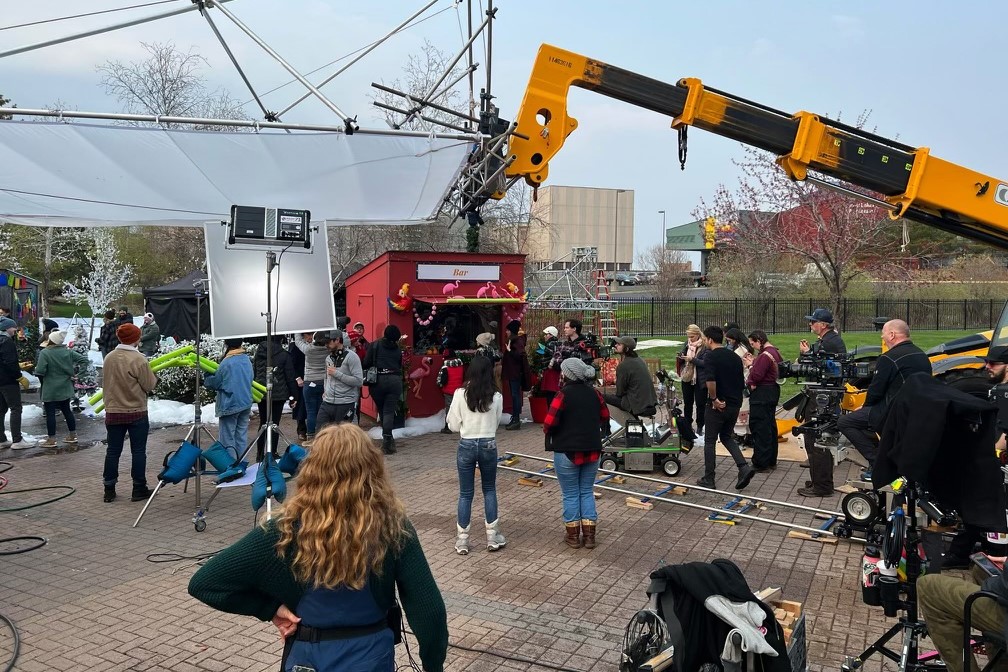
With new state agency and $25 million in tax credits, Minnesota’s film industry in position to boom
From features films like “Downtown Owl” and “Marmalade” to the Christmas movies “Merry Kiss Cam” and “Rescuing Christmas” to the upcoming season of Netflix’s wildly popular series “Love Is Blind,” projects shot in the Twin Cities and greater Minnesota seem to be popping up everywhere these days.
There’s about to be even more of them, thanks to the creation of the new state agency Explore Minnesota Film and the $25 million in tax credits it will issue to filmmakers who shoot in the state.
“We are now in the position to actually be considered competitive in landing more features and hopefully series,” said deputy director Melodie Bahan. “This puts Minnesota in the conversation with the industry.”
From boom to bust and back
For decades, Minnesota stood as the only state to have a nonprofit, rather than a government agency, helping to provide resources to filmmakers and to promote the state as a filming location. MN Film & TV was founded in 1983, a time when more than 20 states had already established film commissions, including Colorado, Texas and Illinois.
Several years earlier, Robert Redford chose to shoot “Ordinary People,” based on the novel by Minnesota author Judith Guest, in Illinois rather than Minnesota, because of the lack of a state film office. A small group led by Guest and entertainment attorney John Stout attempted to get the state to found its own. When the Legislature declined, MN Film & TV stepped up to the plate.
RELATED: 5 Minnesota-made movies you can stream right now
Prince helped put Minnesota on the film industry map with “Purple Rain,” “Sign o’ the Times” and “Graffiti Bridge.” The latter arrived at the beginning of the ’90s, which saw three “Mighty Ducks” and two “Grumpy Old Men” movies shot here along with dozens of others including “Drop Dead Fred,” “Iron Will,” “Untamed Heart,” “Mallrats,” “Drop Dead Gorgeous,” “Jingle All the Way,” “Feeling Minnesota” and “Fargo.”
Actor Walter Matthau, right, shown with actor Jack Lemmon in the 1993 movie “Grumpy Old Men,” on the set in Wabasha, Minn. (Courtesy photo)
But that golden era was short-lived. In 1995, Canada tried something new by offering a federal tax credit to film and television productions, making it financially attractive to shoot in the Great White North. The gambit worked and it has long since become common for U.S. productions to head north. And that includes — much to Bahan’s consternation — the FX television series based on “Fargo.”
To compete, states began offering either tax credits or rebates. Minnesota went with the latter in 1997 and used MN Film & TV to administer the rebates. But the program was defunded in 2002 and by the time the funding returned four years later, numerous states like Georgia had established aggressive incentive programs and made the entire process much more competitive.
From 2014 to 2017, MN Film & TV certified 239 projects for rebates with the state’s $18 million investment, which led to at least $82.5 million in direct spending in Minnesota and attracted indie films like “Dear White People,” “Thin Ice” and “The House of Tomorrow.” In 2017, the Legislature didn’t drop the rebate program but reduced its budget to $500,000 a year, which limited the state’s ability to attract feature films.
Crews work on a night shoot for the Hallmark movie “Rescuing Christmas,” which was shot in Duluth in the spring of 2023. The $3.1 million budget film was given $572,168 in tax credits from the new Explore Minnesota Film office. (Courtesy of the Upper Midwest Film Office)
The transition from nonprofit to state agency began in 2021 when the state offered up $5 million in funding and, crucially, moved from a rebate program to tax credits. Bahan said tax credits are more reliable and stable, as productions know they will be in place for years to come. In 2023, the Legislature expanded the program to $25 million and extended the sunset date to 2030. Minnesota joins the 45 other states that have film offices.
Economic impact of film industry
The state established Explore Minnesota Film, Bahan said, because the tax credits cannot be administered by anyone but a state agency. Bahan, who previously ran MN Film & TV, has helped oversee the ceasing of operations of the nonprofit, which should be complete by next month.
Explore Minnesota Film will have three employees and an annual budget of $825,000. “That amount added nothing to the state budget,” Bahan said. “The funds were taken from appropriations the state was already making to support the operations of the nonprofit.”
So what does all the money get Minnesota, besides bragging rights?
Ten projects — mostly feature films, along with a documentary, television series and a package of Mattel commercials — have been shot and finished post-production and a required audit since the state implemented tax credits were established.
According to the Minnesota Department of Employment and Economic Development’s website, those 10 projects cost a total of $22.1 million, with $3.7 million in tax credits issued. They generated $10.1 million in wages and another $715,000 in income taxes, unemployment insurance and municipal fees.
“In addition to the salaries and taxes, the projects pump cash directly into small businesses wherever they are shooting, whether that’s restaurants or hardware stores or small hotels,” Bahan said.
Seven more projects — including an Andrew Zimmern television show and the feature films “Bigfoot Woods” and “Lunch Hour” — have received funding and are at various points of completion.
Selling Minnesota to Hollywood
After COVID shutdowns, a year’s worth of strikes and issues with streaming profitability, the film and television industry has effectively gone through a reboot. Budgets and spending are down. But Bahan is optimistic about the future of Minnesota’s film industry.
“I was out in L.A. a few weeks ago and what I was hearing from studio execs is that the days of freewheeling spending have come to an end. We’re going to see smaller budgets. But for Minnesota, we’re perfectly positioned for that,” she said.
Van Hayden is a longtime filmmaker who has worked in the industry for 35 years and was assistant director on more than 70 films and television shows. He left Minneapolis in 1989 to work in the industry, first in New York and then Los Angeles.
He returned to Minnesota six years ago, mostly for family reasons, but he’s happy to have opportunities to continue working in his home state.
“We’ve got even footing with the big players,” Hayden said. “I was on a phone call today with a producer who wants to bring an $8 million production here and shoot in the Arrowhead. I think the future for Minnesota — the entire state — is very bright.”
One of the state’s great selling points, he said, is that it’s midway between both coasts and easily accessible by air to two other major film hubs, Chicago and Atlanta.
Bahan said other perks to shooting in Minnesota include the state’s four seasons, the geographic diversity and the talent pool of crew members and actors.
“You can reach Minnesota from any major city on a direct flight,” she said. “Within 30 minutes of landing, you can be in an urban setting, or a farm, or a forest. That is something that is really unique to Minnesota. And we can double for pretty much everywhere except the tropics.”
Mike Handley owns Tasty Lighting Supply, a Minneapolis company that rents lighting and other equipment to film, television and commercial productions. He likes what he hears about potential projects happening in the state in the new year.
“I think for a lot of us in the film community, we’re excited at the possibilities of more and larger feature work here,” he said. “It helps broaden everybody’s skill level and it brings in more younger people into the industry.”
Bahan said the state’s investment in the industry spoke volumes about what’s to come.
“It’s pretty clear that having a state investment in these tax credits means the state was really taking the industry seriously as a potential economic boom,” she said. “More productions, more spending, more jobs available to Minnesotans. That’s the goal.”
Related Articles
‘The Substance’ review: Demi Moore is a Hollywood veteran who risks everything on a new body of work
‘Wolfs’ review: Clooney and Pitt cut a caper, on the thin line between ‘relaxed’ and ‘lax’
Blue tongues and an exposed brain: How ‘Beetlejuice Beetlejuice’ visual effects went back to basics
‘The Wild Robot’ review: Dazzling piece of animation interested in adaptation
‘The Killer’s Game’ review: Bautista action-comedy romp only so fun


